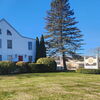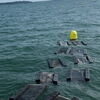Processing Your Payment
Please do not leave this page until complete. This can take a few moments.
- News
-
Editions
View Digital Editions
Biweekly Issues
- December 1, 2025
- Nov. 17, 2025
- November 03, 2025
- October 20, 2025
- October 6, 2025
- September 22, 2025
- + More
Special Editions
- Lists
- Viewpoints
-
Our Events
Event Info
Award Honorees
- Calendar
- Biz Marketplace
Auburn Manufacturing: Innovation on fire
 2009 file Photo / David A. Rodgers
Kathie Leonard, president and CEO of Auburn Manufacturing Inc.
2009 file Photo / David A. Rodgers
Kathie Leonard, president and CEO of Auburn Manufacturing Inc.
MECHANIC FALLS — Auburn Manufacturing, a 50-employee business founded in 1979, develops, manufactures and markets textile products for extreme-temperature industrial applications.
At one time, production and shipping took place at three facilities in Mechanic Falls and Auburn, a system that evolved organically and worked perfectly well toward achieving a great reputation.
Still, founder and CEO Kathie Leonard was aware of inefficiencies: They weren’t getting product out the door as quickly as customers needed. Product development was slow, too. But she was unable to identify the bottlenecks.
“Say a customer needed 500 rolls of high-temperature tape to be used as door seals in equipment,” Leonard says. “We would weave the tape in one plant, then truck it to get coated at our other plant. Then it would come back to the first plant to get pressure-sensitive adhesive applied. Then we would truck it to our warehouse, to be stored or shipped.”
In 2012, they started to work with Wayne Messer, project manager with the Maine Manufacturing Extension Partnership, a fee-for-service organization that helps small and medium-sized manufacturers become more efficient, productive and globally competitive. With Suzanne Hamlin from Transformational Knowledge Group, the team used external assessments and a baseline financial forecast to analyze market dynamics, company priorities and corporate-wide operational metrics. Leonard worked with Messer on a strategic planning process that included developing new space, new markets and new products.
The result?
“We’re a lot more focused in terms of where we’re going,” Leonard says.
For example, to solve that production tangle, the team walked through the production process, tracing materials through the three facilities.
“That’s just the way we grew,” says Leonard. “It turned out, we were going around in circles many times.”
Ultimately, the solution was to ditch the leased warehouse and invest $1.4 million to expand the Auburn plant from 30,000 square feet to about 50,000 square feet, and purchase an additional oven system that speeds capacity for coating and heat-treating fabrics, enabling the company to develop products more quickly.
Leonard credits Lewiston-Auburn’s business-friendly environment for obtaining financing easily.
“I think the banks understand what manufacturing needs,” she says. “They’ve been with us all along.”
Leonard had thought about expanding, but MEP helped clarify its usefulness for the company’s growth.
“If you stand still in business, you tend to start going backward,” she says. “This needed to be a 21st century business.”
The company expresses its renewed drive in a new tagline, changing it from “The safest name in high heat resistant textiles” to “Innovation on fire.” It hired a vice president of innovation and engineering. And it is indeed on fire. New products include a pre-assembled valve insulation kit, marketed to institutions and municipalities — the first time the company moved beyond industrial customers.
Leonard and Messer continue to work together.
“Had we not invested in the training we obtained from MEP, we may now have been wondering what to do next,” she says. “Instead, we’re setting in place another three-year plan.”
Read more
Auburn Manufacturing wins early ruling on Chinese imports
Auburn Manufacturing scores victory with duty on Chinese textiles
Mainebiz web partners

The Giving Guide
The Giving Guide helps nonprofits have the opportunity to showcase and differentiate their organizations so that businesses better understand how they can contribute to a nonprofit’s mission and work.
Learn More
Work for ME
Work for ME is a workforce development tool to help Maine’s employers target Maine’s emerging workforce. Work for ME highlights each industry, its impact on Maine’s economy, the jobs available to entry-level workers, the training and education needed to get a career started.
Learn More
Groundbreaking Maine
Whether you’re a developer, financer, architect, or industry enthusiast, Groundbreaking Maine is crafted to be your go-to source for valuable insights in Maine’s real estate and construction community.
Learn more-
The Giving Guide
The Giving Guide helps nonprofits have the opportunity to showcase and differentiate their organizations so that businesses better understand how they can contribute to a nonprofit’s mission and work.
-
Work for ME
Work for ME is a workforce development tool to help Maine’s employers target Maine’s emerging workforce. Work for ME highlights each industry, its impact on Maine’s economy, the jobs available to entry-level workers, the training and education needed to get a career started.
-
Groundbreaking Maine
Whether you’re a developer, financer, architect, or industry enthusiast, Groundbreaking Maine is crafted to be your go-to source for valuable insights in Maine’s real estate and construction community.
ABOUT
NEW ENGLAND BUSINESS MEDIA SITES
No articles left
Get access now
In order to use this feature, we need some information from you. You can also login or register for a free account.
By clicking submit you are agreeing to our cookie usage and Privacy Policy
Already have an account? Login
Already have an account? Login
Want to create an account? Register
Get access now
In order to use this feature, we need some information from you. You can also login or register for a free account.
By clicking submit you are agreeing to our cookie usage and Privacy Policy
Already have an account? Login
Already have an account? Login
Want to create an account? Register






Comments